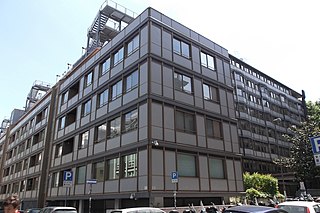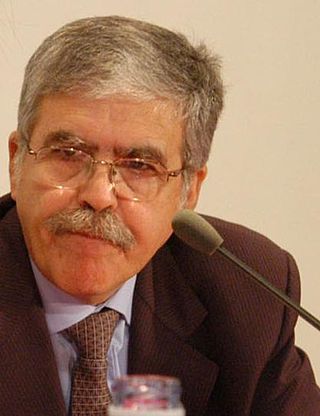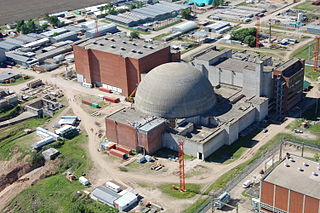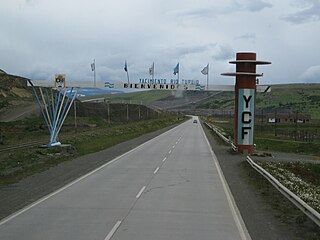
The National Atomic Energy Commission is the Argentine government agency in charge of nuclear energy research and development.

The Nuclear Power Plant in Cernavodă is the only nuclear power plant in Romania. It produces around 20% of the country's electricity. It uses CANDU reactor technology from AECL, using heavy water produced at Drobeta-Turnu Severin as its neutron moderator and as its coolant agent. The Danube water is not used for cooling of the active zone.

Enel S.p.A. is an Italian multinational manufacturer and distributor of electricity and gas. Enel, which originally stood for Ente nazionale per l'energia elettrica, was first established as a public body at the end of 1962, and then transformed into a limited company in 1992. In 1999, following the liberalisation of the electricity market in Italy, Enel was privatised. The Italian state, through the Ministry of Economy and Finance, is the main shareholder, with 23.6% of the share capital as of 1 April 2016.

The Embalse Nuclear Power Station is one of three operational nuclear power plants in Argentina. It is located on the southern shore of a reservoir on the Río Tercero, near the city of Embalse, Córdoba, 110 km south-southwest of Córdoba City.
Embalse is a city in the center-west of the province of Córdoba, Argentina, located within the Calamuchita Valley, 119 km south-southwest from Córdoba City. The municipality has 15,000 inhabitants as per the 2001 census [INDEC], though unofficial counts including the neighboring areas give a population of over 30,000, which grows by several thousands during the tourist high season.

INVAP S.E. is an Argentine company that provides design, integration, construction and delivery of equipment, plants and devices. The company operates in North America, Europe, Asia Pacific, Latin America, the Middle East and Africa, and delivers projects for nuclear, aerospace, chemical, medical, petroleum and governmental sectors.

Eesti Energia AS is a public limited energy company in Estonia with its headquarters in Tallinn. It is the world's biggest oil shale to energy company. The company was founded in 1939. As of 2014, it operates in Estonia, Latvia, Lithuania, Finland, Jordan and Utah, United States. In Estonia, the company operates under the name Eesti Energia, while using the brand name Enefit for international operations. The main raw material for energy production – oil shale – is extracted from mines located in Eastern-Estonia and owned by the company. The group of Eesti Energia has three main operation areas: electricity generation, shale oil production, and sale and distribution of electricity. Its shares are owned by the Government of Estonia.

Brazil is the 10th largest energy consumer in the world and the largest in South America. At the same time, it is an important oil and gas producer in the region and the world's second largest ethanol fuel producer. The government agencies responsible for energy policy are the Ministry of Mines and Energy (MME), the National Council for Energy Policy (CNPE), the National Agency of Petroleum, Natural Gas and Biofuels (ANP) and the National Agency of Electricity (ANEEL). State-owned companies Petrobras and Eletrobras are the major players in Brazil's energy sector, as well as Latin America's.
The electricity sector in Argentina constitutes the third largest power market in Latin America. It relies mostly on thermal generation and hydropower generation (36%). The prevailing natural gas-fired thermal generation is at risk due to the uncertainty about future gas supply.

Visaginas Nuclear Power Plant was a planned nuclear power plant project in Lithuania. It was proposed to be built at the site of the closed Ignalina Nuclear Power Plant, which was shut down on 31 December 2009 in accordance with Lithuania's accession agreement to the European Union. The two reactors of the Ignalina plant are currently undergoing a decommissioning process.

Julio Miguel de Vido is an Argentine politician who was Minister of Planning and Public Investment between 2003 and 2015.

Energy in Uruguay describes energy and electricity production, consumption and import in Uruguay.

CAREM is a small modular reactor for electrical power generation currently under construction near the city of Zárate, in the northern part of Buenos Aires province beside the Atucha I Nuclear Power Plant.
The use of nuclear energy in Uruguay is prohibited by law 16.832 of 1997. Despite this, the country has several institutions that regulate its use, such as the Center for Nuclear Research or the National Regulation Authority on Radiological Protection.
In Argentina, about 10% of the electricity comes from 3 operational nuclear reactors: Embalse, a CANDU reactor, and Atucha I and II, two PHWR German designs.

The Atucha Nuclear Complex, or Atucha Nuclear Power Plant, is the location for two adjacent nuclear power plants in Lima, Zárate, Buenos Aires Province, about 100 kilometres (60 mi) from Buenos Aires, on the right-hand shore of the Paraná de las Palmas River. Both are pressurized heavy-water reactors (PHWR) employing a mixture of natural uranium and enriched uranium, and use heavy water for cooling and neutron moderation.

The Hualong One is a Chinese Generation III pressurized water nuclear reactor jointly developed by the China General Nuclear Power Group (CGN) and the China National Nuclear Corporation (CNNC). The CGN version, and its derived export version, is called HPR1000. It is commonly mistakenly referred to in media as the "ACPR1000" and "ACP1000", which are in fact earlier reactors design programs by CGN and CNNC.

Yacimientos Carboníferos Río Turbio is an Argentine coal mining company created in 1994 to replace Yacimientos Carboníferos Fiscales, along with the privatization of many other state-owned enterprises, the trademark of the national administration of the time. It was created to extract, ship and sell the coal from Rio Turbio and its coal basin. It is the only coal mine in all of Argentina and a geopolitical key are, since it is located in the south west extreme of the country, one of the furthest south settlements of the country.













